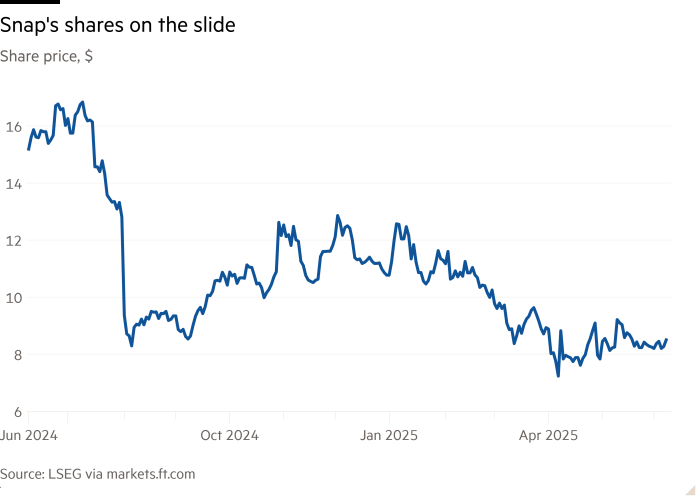Snap to launch ‘Specs’ smart glasses to revive challenge to Meta and Apple

Unlock the Editor’s Digest for free
Roula Khalaf, Editor of the FT, selects her favourite stories in this weekly newsletter.
Snap plans to relaunch its smart glasses to consumers next year, as the social media company rejoins a costly battle with Meta, OpenAI and Apple to create new artificial intelligence-powered wearable devices.
The Los Angeles-based company on Tuesday announced a new device called “Specs”, a decade after its first camera glasses, which after an initial buzz of excitement ultimately failed to catch on with consumers.
Since then, chief executive Evan Spiegel has invested more than $3bn to build and develop Snap’s own proprietary hardware, optical components and operating system for “augmented reality” eyewear that combines AI image recognition and the ability to display high-resolution 3D images.
“I think there’s a real understanding now that computers are going to need to evolve really meaningfully to fully realise the benefits and the advancements in AI,” he told the Financial Times.
“I think investors now understand the need for a new type of computer . . . If you look historically at computers, they haven’t really been designed to bring out the best in humanity.”
The breakout success of OpenAI’s ChatGPT and other chatbot assistants has triggered a multibillion-dollar race in Silicon Valley to develop new AI-enabled products that could replace the smartphone. This includes OpenAI’s $6.4bn acquisition of former Apple design chief Sir Jony Ive’s hardware start-up io last month.
The parent company of social media app Snapchat also faces Big Tech rivals in the race to build “wearable computing”.
Meta has had some success with its “Ray-Ban Meta” smart glasses collaboration with French-Italian eyewear giant EssilorLuxottica, while also pushing ahead with its own AR glasses prototype, Orion. Apple released its “mixed reality” Vision Pro headset last year, although sales have been limited so far.
Spiegel said Snap’s Specs would take advantage of growing interest in new devices that use AI in ways that today’s smartphones cannot. “A lot of the various necessary pieces have come together to enable this new product,” he said.
Snap’s chief added he was not worried about resistance from investors over the higher risk and capital costs involved in consumer hardware — something it learned in 2017 when it wrote off $40mn worth of excess inventory for unsold smart glasses.
Despite growing Snapchat’s audience of monthly active users to more than 900mn, Snap’s shares have lost almost half their value over the past year, as it faces intense competition for advertising dollars from Meta and TikTok. Since going public in 2017, it has never reported an annual profit.
That has not stopped Spiegel — who along with co-founder Bobby Murphy holds majority voting control of the company through a special class of stock — from betting that smart glasses can be the breakthrough that vaults Snap into tech’s big leagues.
“What’s been really important is our ability to invest consistently in this vision over the last 11 years,” Spiegel said. “If we can achieve any sort of consumer scale, the business itself is incredibly meaningful.”
Snap is withholding many details of Specs, including its price and what it looks like, until closer to launch. Spiegel said the device would be powered by a Qualcomm Snapdragon processor and can operate fully standalone, without needing to connect to a smartphone or any other accessory like the tethered “puck” needed to power Apple’s Vision Pro.
“In our experiments so far, that’s been very important for usability,” he said.
In 2021, Snap acquired WaveOptics, a UK supplier of “waveguide” optical systems that use tiny prisms to create holographic images.
The first version of what was previously known as Spectacles to include a display was launched in 2021, but was only sold to app developers. An updated developer kit was released last year.
Snap is using a combination of its own visual AI system and integrations with OpenAI, Google’s Gemini and DeepSeek to power Specs.
Spiegel hopes giving Specs the ability to see and understand what their users look at, then overlay useful information in exactly the right place through their display, will make the product more useful than today’s smart glasses such as Meta’s Ray-Bans that rely on microphones to talk to an AI assistant.
“The real exercise for us in the coming years will be helping the broader community differentiate between basic smart glasses and immersive AR glasses,” Spiegel said.
“The difference with Specs is that you’ll be able to have a full workstation, you’ll be able to use immersive lenses together with your friends, you’ll be able to bring AI into the world with you — instead of just interacting via voice or with a tiny screen.”




